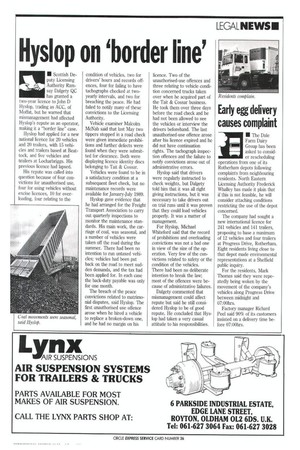Hyslop on 'border line' • Scottish Deputy Licensing Authority Ramsay
Page 19

If you've noticed an error in this article please click here to report it so we can fix it.
Dalgety QC has granted a two-year licence to John D Hyslop, trading as ACC, of Moffat, but he warned that mismanagement had affected Hyslop's repute as an operator, making it a "border line" case.
I lyslop had applied for a new national licence for 20 vehicles and 20 trailers, with 15 vehicles and trailers based at Beattock, and five vehicles and trailers at Locharbriggs. His previous licence had lapsed.
His repute was called into question because of four convictions for unauthorised use, four for using vehicles without excise licences, 10 for overloading, four relating to the condition of vehicles, two for drivers' hours and records offences, four for failing to have tachographs checked at twoyearly intervals, and two for breaching the peace. He had failed to notify many of these convictions to the Licensing Authority.
Vehicle examiner Malcolm McNab said that last May two tippers stopped in a road check were given immediate prohibitions and further defects were found when they were submitted for clearance. Both were displaying licence identity discs belonging to Tait & Cossar.
-Vehicles were found to be in a satisfactory condition at a subsequent fleet check, but no maintenance records were available for January-July 1989.
Hyslop gave evidence that he had arranged for the Freight Transport Association to carry out quarterly inspections to monitor the maintenance standards. His main work, the carriage of coal, was seasonal, and a number of vehicles were taken off the road during the summer. There had been no intention to run untaxed vehicles; vehicles had been put back on the road to meet sudden demands, and the tax had been applied for. In each case the back-duty payable was only for one month.
The breach of the peace convictions related to matrimonial disputes, said Hyslop. The first unauthorised use offence arose when he hired a vehicle to replace a broken-down one, and he had no margin on his licence. Two of the unauthorised-use offences and three relating to vehicle condition concerned trucks taken over when he acquired part of the Tait & Cossar business. He took them over three days before the road check and he had not been allowed to see the vehicles or interview the drivers beforehand. The last unauthorised-use offence arose after his licence expired and he did not have continuation rights. The tachograph inspection offences and the failure to notify convictions arose out of administrative errors.
Hyslop said that drivers were regularly instructed to check weights, but Dalgety told him that it was all right giving instructions, but it was necessary to take drivers out on trial runs until it was proven that they could load vehicles properly. It was a matter of management.
For Hyslop, Michael Whiteford said that the record of prohibitions and overloading convictions was not a bad one in view of the size of the operation. Very few of the convictions related to safety or the condition of the vehicles. There had been no deliberate intention to break the law; most of the offences were because of administrative failures.
Dalgety commented that mismanagement could affect repute but said he still considered Hyslop to be of good repute. He concluded that Hyslop had taken a very casual attitude to his responsibilities.




































































































